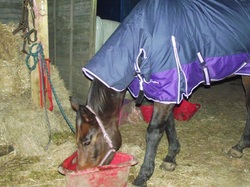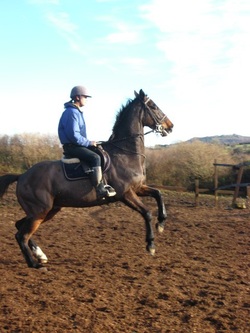Oakley Sports Horses
Tieing Up

Simple trick to stop horses from pulling back when tied up and snapping their ropes/headcollars etc. When he arrived, Brazil was a master at the art of breaking free. He would be tied up for no more than about 2 minutes before he would just pull back and snap the baler twine that he was tied to. The simple solution was just to loop the rope through the baler twine, but not tie it. When he pulled back there was nothing to pull against. (You do need to be close at hand though when using this method and make sure the yard gate is closed! Ideally hold onto the very end of the rope but without applying any pressure to it.) He tried pulling back against nothing about 4 times and then gave up and has never done it since. He now ties up beautifully anywhere, with or without a haynet (or a feed).
Always tie a horse to a loop of baler twine that can break in an emergency and use quick release knots. Never use stronger ropes to stop horses from breaking free. It just causes them to panic more and continue the behaviour of pulling back. If they can't break free they can cause serious damage to themselves (and any other objects in the immediate vicinity).
Always tie a horse to a loop of baler twine that can break in an emergency and use quick release knots. Never use stronger ropes to stop horses from breaking free. It just causes them to panic more and continue the behaviour of pulling back. If they can't break free they can cause serious damage to themselves (and any other objects in the immediate vicinity).
Napping

Horses nap to tell you they really don't want to do something. Often, with young and inexperienced horses it is because they feel overfaced by something and would much rather return to their friends in the yard, than finish their schooling session. Napping varies from running back to the gate of the school, refusing to budge when they get to the gate or the full range of leaping, plunging and rearing that comes with very highly strung horses (such as Tommy). If its not dealt with effectively it can become habitual. We have successfully dealt with many nappy horses using these simple methods:
1 Stay calm yourself and sit very quietly and still on your horse. Don't flap, shout, lose your temper or resort to the whip. Whilst some of these may produce short term results they don't produce a calm and willing horse in the long run;
2 Wait until the horse has finished whatever it is doing and then quietly ask it to go forwards again. Make sure that you turn it the way you originally asked it to go and do not let it go the way it wants to go. If the horse resists, just sit quietly, wait until its finished and ask again.
3 Have someone on hand on the ground who can assist leading you away from the napping spot if necessary. If the horse still resists just keep trying quietly. Eventually the horse will get bored and move on.
4 Let the horse follow the person on foot for a while and then let the person drop back to the horses shoulder and then gradually move away from the horse, until the horse is walking alone.
5 If you are working on a circle and the horse is napping at one end, go to the other end of the school and start working on a small circle for a while. Then start to ride the circle a little larger with each circuit. As soon as the horse starts to show signs of preparing to nap, take it back on to a smaller circle while it settles and then start to gradually increase the size of the circle again. Keep repeating until you are happily doing a large circle round the whole school. This technique was brilliantly successful with the nappiest horse we had, where all other methods had failed. We only had to do this exercise once and after that had no further problems with him.
1 Stay calm yourself and sit very quietly and still on your horse. Don't flap, shout, lose your temper or resort to the whip. Whilst some of these may produce short term results they don't produce a calm and willing horse in the long run;
2 Wait until the horse has finished whatever it is doing and then quietly ask it to go forwards again. Make sure that you turn it the way you originally asked it to go and do not let it go the way it wants to go. If the horse resists, just sit quietly, wait until its finished and ask again.
3 Have someone on hand on the ground who can assist leading you away from the napping spot if necessary. If the horse still resists just keep trying quietly. Eventually the horse will get bored and move on.
4 Let the horse follow the person on foot for a while and then let the person drop back to the horses shoulder and then gradually move away from the horse, until the horse is walking alone.
5 If you are working on a circle and the horse is napping at one end, go to the other end of the school and start working on a small circle for a while. Then start to ride the circle a little larger with each circuit. As soon as the horse starts to show signs of preparing to nap, take it back on to a smaller circle while it settles and then start to gradually increase the size of the circle again. Keep repeating until you are happily doing a large circle round the whole school. This technique was brilliantly successful with the nappiest horse we had, where all other methods had failed. We only had to do this exercise once and after that had no further problems with him.